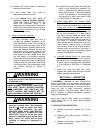
7
d) Depress push button marked “LEFT” to
traverse in the opposite direction.
CAUTION
Excessive “jogging” will cause
premature burning of contact tips, motor
overheating, and premature brake wear.
e) On two-speed hoist or trolley motions, partial
depression of a button operates hoist or
trolley at slow speed; depressing button
completely operates hoist or trolley at full
speed.
3-3. OPERATING PRECAUTIONS. Safe operation
of an overhead hoist is the operator’s responsibility.
Listed below are some basic rules that can make an
operator aware of dangerous practices to avoid and
precautions to take for his own safety and the safety
of others. Observance of these rules in addition to
frequent examinations and periodic inspection of the
equipment may save injury to personnel and
damage to equipment.
WARNING
Equipment covered herein is not
designed or suitable as a power source
for lifting or lowering persons.
a) DO read ASME B30.16 Safety Standard for
Overhead Hoists and the Operation, Service
and Parts Manual.
b) DO be familiar with hoist operating controls,
procedures, and warnings.
c) DO make sure hook travel is in the same
direction as shown on the controls. If
opposite direction occurs, see Pre-Operation
Checks, Section II, Paragraph 2-4.b.
d) DO make sure hoist limit switches function
properly.
e) DO maintain firm footing when operating
hoist.
f) DO make sure that the load slings or other
approved single attachments are properly
sized and seated in the hook saddle.
g) DO make sure that the hook latch is closed
and not supporting the load.
h) DO make sure that load is free to move and
will clear all obstructions.
i) DO take up slack carefully, check load
balance, lift a few inches and check load’s
holding action before continuing.
j) DO avoid swinging of load or load hook.
k) DO make sure that all persons stay clear of
the suspended load.
l) DO warn personnel of an approaching load.
m) DO protect wire rope from weld splatter or
other damaging contaminants.
n) DO promptly report any malfunction,
unusual performance, or damage of the
hoist.
o) DO inspect hoist regularly, replace damaged
or worn parts, and keep appropriate records
of maintenance.
p) DO use the hoist manufacturer’s recom-
mended parts when repairing a hoist.
q) DO use hook latches.
r) DO apply lubricant to the wire rope as
recommended.
s) DO NOT lift more than rated load.
t) DO NOT use the hoist load-limiting device to
measure the load.
u) DO NOT use damaged hoist or hoist that is
not working properly.
v) DO NOT use the hoist with twisted, kinked,
damaged, or worn wire rope.
w) DO NOT lift a load unless wire rope is
properly seated in its groove(s).
x) DO NOT use wire rope as a sling or wrap
rope around the load.
y) DO NOT lift a load if any binding prevents
equal loading on all supporting ropes.
z) DO NOT apply the load to the tip of the
hook.
aa) DO NOT operate unless load is centered
under hoist.
bb) DO NOT allow your attention to be diverted
from operating the hoist.
cc) DO NOT operate the hoist beyond limits of
wire rope travel.


















